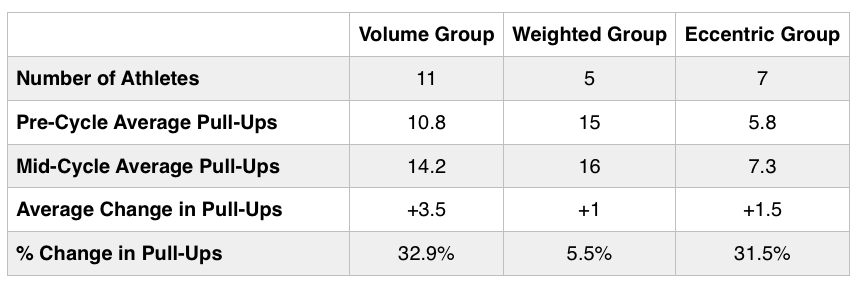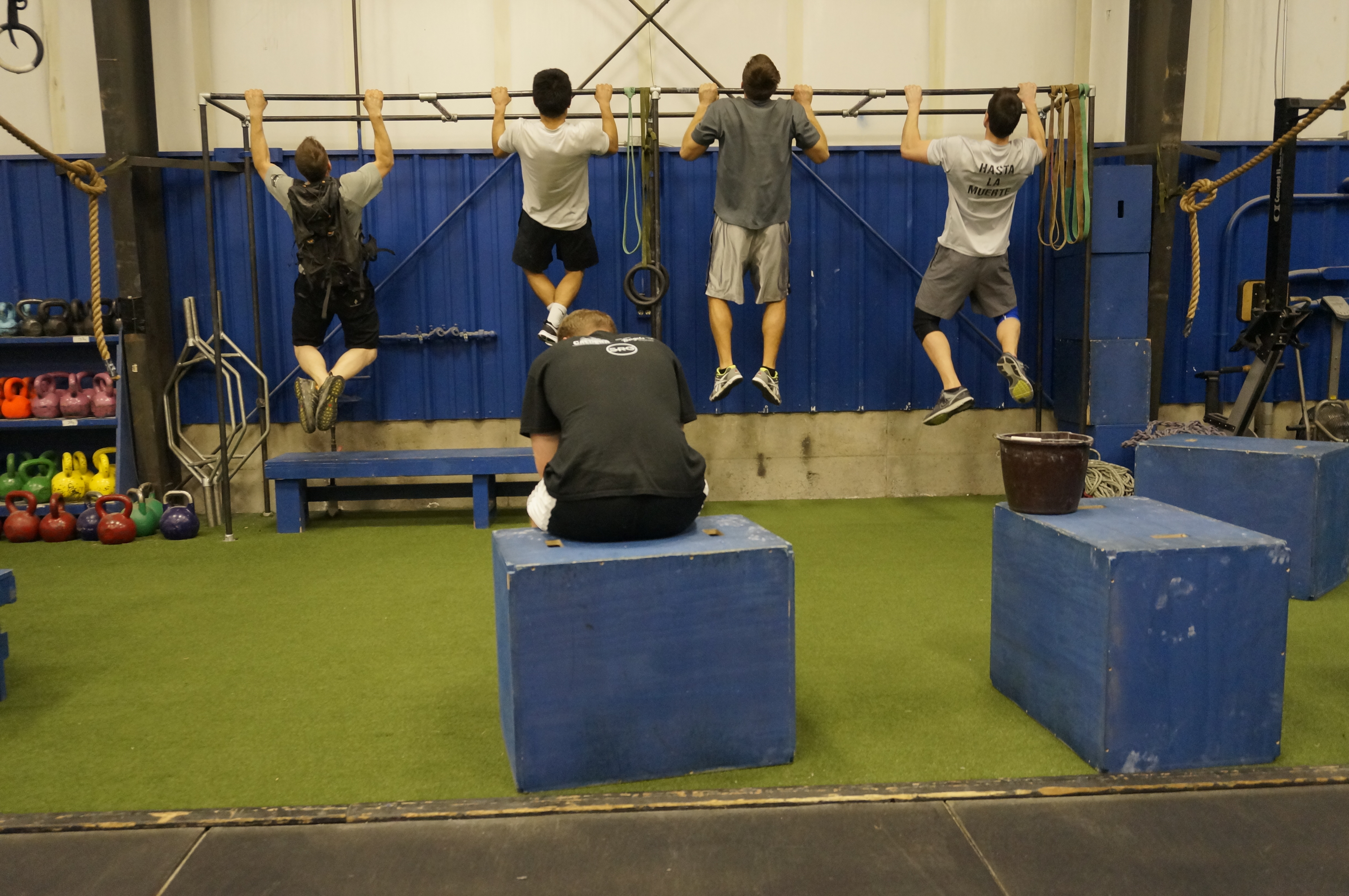Adam Scott, MS, CSCS
Last week marked the mid-way point for our 6-week 3 method pull-up training experiment. On Tuesday we conducted a mid-cycle assessment to see how our programs were performing. It’s only been 3 weeks but we are already seeing some pretty impressive results.
Methods (Quick Summary):
Three weeks ago we divided our athletes into 3 pull-up training groups: (1) Volume Training, (2) Weighted Pull-Up Training, and (3) Eccentric Pull-Up Training. Within each group we categorized our athletes based on their initial pull-up scores so that we could scale their training (0-4 Reps, 5-12 Reps and over 12 Reps).
Each group will train twice a week for 6 weeks. After 6 weeks we will retest each athlete and compare the three training methods.
Results:
Volume Training Group:
Results: Every single athlete who completed the mid-cycle assessment increased their pull-up scores. Improvements ranged from +1 pull-up to +10 pull-ups.
Training Observations: Our volume training started off at just 5 minutes (which most of the athletes found pretty easy). From there we progressed pretty quickly by adding both time and reps. Our athletes started at about 175% of their max score (in 5 minutes). By the end of the third week they were at 266% (in 7 minutes).
The athletes in this group varied from 5 pull-ups to 27 pull-ups on the initial assessment and they all seemed to handle the increases well. There were times when some individuals had to break-up a set, but everyone was able to complete the prescribed repetitions and progressions.
Dividing the sessions into 60 sec intervals on Tuesday and 30 sec intervals on Thursday broke up the monotony and gave our athletes a different challenge each training day, while keeping the focus of their training consistent.
Weighted Pull-Up Training Group:
Results: Only 2 of the 3 athletes who completed the mid-cycle assessment increased their pull-up scores. Changes in scores ranged from -1 to +3 pull-ups.
Training Observations: All of the athletes in the weighted training group were in the highest category during the initial assessment (>12 Pull-Ups). They began their weighted training at 10% over body weight and progressed to 12.5% in week 2 and 15% in week 3.
We tracked the total number of pull-ups each athlete completed during the session (5 rounds) and found that they stayed pretty consistent even with the increase in weight.
Looking at the numbers, even when we factor in the increase in weight, I am not sure our weighted protocol is going to be intense enough to produce big gains from our athletes. On the high end, they were doing 30-32 weighted pull-ups over 5 rounds. On the low end it was between 19-20 pull-ups. This works out to between 6.4 and 3.8 pull-ups per round.
Eccentric Training Group:
Results: Results from this group were difficult to interpret because of the wide range of athletes. Initial scores ranged from 0 pull-ups to 34 pull-ups, the average for the group was 5.8 pull-ups. Overall, 4 athletes improved and 3 stayed the same. The average change for this group was +1.5 pull-ups.
Our highest athlete increased from 34 pull-ups to 41 pull-ups, an increase of 20.6%
As of yet, no athlete has made the jump from 0 to 1 pull-ups.
Observations: The first thing we observed was that eccentric pull-up training was brutal for athletes who could not perform a single repetition pull-up — our athletes were almost too sore to train after the first session. Four reps at 5 seconds each is probably too high to start. I would recommend starting at 2-3 reps max.
I also think that we may have rushed adding weight to the movement. For the higher scoring athletes in the group the weight increase was fine, but for the athletes starting at zero reps we should have focused more on quality repetitions before progressing.
Although we have not seen any athletes make the jump from 0 reps to 1 rep I anticipate we will have one or two by the end of the cycle based on their increase in movement quality.
Overall Comparison:
At the half-way point in our cycle the Volume Training Group and the Eccentric Training Group are definitely distinguishing themselves. The Weighted Training Group is showing progress, but at a much slower pace.

Personally, I think that the smaller results we are seeing with the Weighted Training Group are more a product of our protocol (set and rep schemes) then a general indictment on weighted pull-ups.
We also have a very small, homogeneous pool of athletes training with weighted pull-ups so it is going to be difficult to tease out what factors could be influencing performances.
The Volume Training Group is showing the most promise at this point – which is not a huge surprise. Volume training is probably the most applicable mode of training for a maximum repetition test. We have seen great success with volume training for push-ups and sit-ups in the past.
Every single Volume Training Group athlete improved. There were a few very large improvements which skewed the results a little, but still the fact that every single athlete improved shows that this is an effective training design.
Lastly, the Eccentric Group – based on what we have seen in just three weeks it seems like eccentric training might be an effective tool for both high scoring and low scoring athletes. On the high end, a 20% jump from 34 to 41 pull-ups is almost unheard of. On the lower end we saw jumps from 1 to 2 pull-ups and 4 to 6 pull-ups – both very impressive 50% increases.
However, the biggest question we have for this group still remains – whether or not it will be effective for our zero rep athletes. So far no athlete has made the jump, but we have a few who have shown lots of progress and were very close during the mid-cycle assessment. Hopefully they can make the jump after week the sixth week.
We will check-in with the groups one more time to see how the athletes fair at the end of the cycle (just 2.5 weeks from now).

